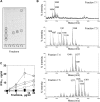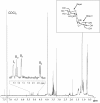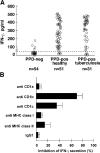Diacylated sulfoglycolipids are novel mycobacterial antigens stimulating CD1-restricted T cells during infection with Mycobacterium tuberculosis
- PMID: 14981115
- PMCID: PMC2213295
- DOI: 10.1084/jem.20031097
Diacylated sulfoglycolipids are novel mycobacterial antigens stimulating CD1-restricted T cells during infection with Mycobacterium tuberculosis
Abstract
Mycobacterial lipids comprise a heterogeneous group of molecules capable of inducing T cell responses in humans. To identify novel antigenic lipids and increase our understanding of lipid-mediated immune responses, we established a panel of T cell clones with different lipid specificities. Using this approach we characterized a novel lipid antigen belonging to the group of diacylated sulfoglycolipids purified from Mycobacterium tuberculosis. The structure of this sulfoglycolipid was identified as 2-palmitoyl or 2-stearoyl-3-hydroxyphthioceranoyl-2'-sulfate-alpha-alpha'-D-trehalose (Ac2SGL). Its immunogenicity is dependent on the presence of the sulfate group and of the two fatty acids. Ac2SGL is mainly presented by CD1b molecules after internalization in a cellular compartment with low pH. Ac2SGL-specific T cells release interferon gamma, efficiently recognize M. tuberculosis-infected cells, and kill intracellular bacteria. The presence of Ac2SGL-responsive T cells in vivo is strictly dependent on previous contact with M. tuberculosis, but independent from the development of clinically overt disease. These properties identify Ac2SGL as a promising candidate to be tested in novel vaccines against tuberculosis.
Figures








References
-
- Kaufmann, S.H. 2001. How can immunology contribute to the control of tuberculosis? Nat. Rev. Immunol. 1:20–30. - PubMed
-
- Gumperz, J.E., and M.B. Brenner. 2001. CD1-specific T cells in microbial immunity. Curr. Opin. Immunol. 13:471–478. - PubMed
-
- Vincent, M.S., J.E. Gumperz, and M.B. Brenner. 2003. Understanding the function of CD1-restricted T cells. Nat. Immunol. 4:517–523. - PubMed
-
- Flynn, J.L., and J. Chan. 2001. Immunology of tuberculosis. Annu. Rev. Immunol. 19:93–129. - PubMed
-
- Stenger, S., and R.L. Modlin. 1999. T cell mediated immunity to Mycobacterium tuberculosis. Curr. Opin. Microbiol. 2:89–93. - PubMed
Publication types
MeSH terms
Substances
LinkOut - more resources
Full Text Sources
Other Literature Sources

